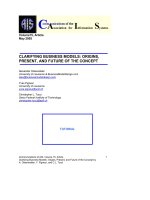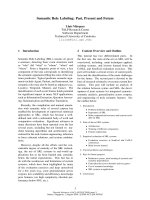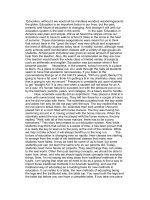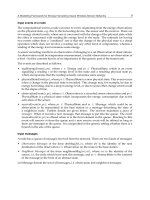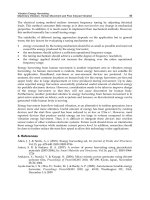The past, present, and future of the business school
Bạn đang xem bản rút gọn của tài liệu. Xem và tải ngay bản đầy đủ của tài liệu tại đây (3.08 MB, 201 trang )
The Past, Present,
and Future of the
Business School
EDWA R D W. M I LES
The Past, Present, and Future
of the Business School
Edward W. Miles
The Past, Present, and
Future of the Business
School
Edward W. Miles
Georgia State University
Lawrenceville, USA
ISBN 978-3-319-33638-1
ISBN 978-3-319-33639-8
DOI 10.1007/978-3-319-33639-8
(eBook)
Library of Congress Control Number: 2016953745
© The Editor(s) (if applicable) and The Author(s) 2016
This work is subject to copyright. All rights are solely and exclusively licensed by the
Publisher, whether the whole or part of the material is concerned, specifically the rights of
translation, reprinting, reuse of illustrations, recitation, broadcasting, reproduction on
microfilms or in any other physical way, and transmission or information storage and retrieval,
electronic adaptation, computer software, or by similar or dissimilar methodology now
known or hereafter developed.
The use of general descriptive names, registered names, trademarks, service marks, etc. in this
publication does not imply, even in the absence of a specific statement, that such names are
exempt from the relevant protective laws and regulations and therefore free for general use.
The publisher, the authors and the editors are safe to assume that the advice and information
in this book are believed to be true and accurate at the date of publication. Neither the publisher nor the authors or the editors give a warranty, express or implied, with respect to the
material contained herein or for any errors or omissions that may have been made.
Cover image © Anton Starikov / Alamy Stock Photo
© A. Astes / Alamy Stock Photo
Printed on acid-free paper
This Palgrave Macmillan imprint is published by Springer Nature
The registered company is Springer International Publishing AG Switzerland
In memory of John D. Hatfield:
Scholar, Teacher, Mentor
PREFACE
In recent decades, a variety of criticisms have fallen at the feet of
university-based business schools. A sampling of these allegations includes
the following: Business schools produce research that is ignored by the
business community as being irrelevant (e.g., Pfeffer & Fong, 2002; The
Economist, 2007). Very few of the innovations in business of the past
half-century have originated in business schools or have been shaped by
them (e.g., Skapinker, 2008). Business schools bear significant responsibility for bad decision making and unethical behavior (e.g., the Enron
scandal) among their graduates (Etzioni, 2002; Ghoshal, 2005; Podolny,
2009). Narrowly focused research specializations lead to professors who
are “siloed” both in their thinking and in their delivery of content in the
curriculum (e.g., Crowther & Carter, 2002; Navarro, 2008; Podolny,
2009). Faculty members have little interest in the critical problems facing
business or in helping to solve them (Bennis & O’Toole, 2005; Thomas
& Wilson, 2011). Business school faculties are populated by academic
scholars who have little business experience. Therefore, business school
graduates have been educated in the practice of a profession by a cadre of
faculty members who are not members of that profession and do not have
a strong desire to relate to that profession (Bennis & O’Toole, 2005).
If even a portion of these concerns have merit, then it would seem
that the university-based business school of today is not delivering optimally on the benefits it alleges to be providing to its stakeholders. Among
others, these stakeholders include students, graduates, employers, financial donors, the collective business community, society at large, and—in
vii
viii
PREFACE
the case of state-funded universities—the taxpayers who help to fund the
activities of the business school.
While various writers of recent decades have quite ably articulated concerns about the current-day business school, they lament (Pfeffer & Fong,
2002; Podolny, 2009) that these concerns are tacitly acknowledged by
business schools and generally ignored by an “ostrich-head-in-the-sand”
lack of response. Why would faculty members and university administrators—drawn from the highest levels of intellectual and reasoning ability in
society—simultaneously acknowledge a serious situation, yet ignore such
seemingly critical concerns? To get a fuller answer to this question than
has been previously offered (or to challenge the pre-supposition of the
question), one must understand the context in which the university-based
business school operates.
One dimension of that context is history. The business school is embedded within the university. The university has a rich history going back to
medieval times. William Faulkner observed that, “The past is never dead.
It’s not even past.” Just as Faulkner’s Mississippi culture lives on forever,
the culture of the modern-day university carries the residue of 800 years of
academic culture going back to the medieval universities of Paris, Bologna,
and others. To gain a complete understanding of the twenty-first century
university-based business school and its alleged shortcomings, one must see
the business school in the context of an 800-year institution in which many
medieval traditions and values have not died—they are not even in the past.
A second dimension of the context is resources and funding. The medieval university had two key benefactors—the king and the church. Both
provided resources necessary for the university to exist. In recent centuries, the university has jettisoned its linkage with the church; in recent
decades, the state (i.e., replacing the role of the king) has become much
less lavish in funding the modern-day university. Never has the phrase “He
who pays the piper calls the tune” resonated more than in the twenty-first
century university. Finding and satisfying constituents who can assure the
funding resources of the university is a task that has changed and evolved
for centuries. The business school operates a microcosm of that same task.
For centuries, the university (and more recently, the business school)
has been quite eager (some would say too eager) to take on new roles to
satisfy these constituents (Collini, 2012; Kerr, 1963/2001). These roles
include offering vocational training to attract more students, conducting
military and medical research to attract government grants, and building
a huge athletic program to curry favor with a variety of constituents. Over
PREFACE
ix
time, the university has come to embody multiple purposes that were
accepted at various points in time for the reason of building favor with
multiple constituents. Just as the broader umbrella of the university, the
business school likewise has taken on many roles for the purpose of satisfying a broad span of constituents. Given that these roles were acquired at
different points in time, based on needs of a broad span of constituents,
it is no surprise that these roles are, at best, non-synergistic, and at worst,
conflicting. For example, big-time athletics and academic integrity conflict
at many universities. In business schools, hiring faculty based solely on
research record conflicts with hiring based on teaching or outreach needs.
A third and final element of the context of the university-based business
school is that it is a professional school. Universities have a myriad of professional schools. What can the business school learn from the experiences
of the university-based medical school, law school, journalism school, or
even music school? Interestingly, few of the criticisms of the business school
(many listed above) are unique. For example, music schools wrestle with
the implications of a “siloed” curriculum; law school observers bemoan
the preponderance of research irrelevant to practice, and medical schools
are accused of placing too much emphasis on research and too little on
teaching. The business school has the opportunity to learn vicariously from
other professional schools regarding these criticisms and how those schools
respond to them. Additionally, a comparison to other professional schools
will give the business school a richer understanding of which criticisms are
solely endemic to business schools and which are actually endemic to multiple professional schools that operate in a university context.
In summary, the twenty-first century university-based business school
has been accused of operating in a manner that, at best, does not influence
the practice of business, and, at worst, is “harmful to society…part of the
problem rather than the solution” (Podolny, 2009, p. 63). Furthermore—
and perhaps more seriously—it has been accused of acknowledging this
situation and implicitly choosing to continue with the status quo. The
purpose of this book is to explain three intertwined dimensions of the
context in which the university-based business school operates: historical
context, resource context, and professional school context. As the context
sheds light on the operating environment of the business school, readers
may decide to re-assess which of the criticisms have merit and the likelihood that potential interventions may result in success or failure.
Lawrenceville, GA
Edward W. Miles
x
PREFACE
REFERENCES
Bennis, W. G., & O’Toole, J. (2005, May). How business schools lost their way.
Harvard Business Review, 96–104.
Collini, S. (2012). What are universities for? London: Penguin Books.
Crowther, D., & Carter, C. (2002). Legitimating irrelevance: Management education in higher education institutions. The International Journal of Educational
Management, 16, 268–278.
Etzioni, A. (2002, August 4). When it comes to ethics, B-schools get an F. The
Washington Post, B4.
Ghoshal, S. (2005). Bad management theories are destroying good management
practices. Academy of Management Learning and Education, 4(1), 75–91.
Kerr, C. (1963/2001). The uses of the university. Cambridge, MA: Harvard
University Press.
Navarro, P. (2008). The MBA core curricula of top-ranked U.S. business schools: A
study in failure? Academy of Management Learning and Education, 7(1), 108–123.
Pfeffer, J., & Fong, C. T. (2002). The end of business schools? Less success than
meets the eye. Academy of Management Learning and Education, 1(1), 78–95.
Podolny, J. M. (2009, June). The buck stops (and starts) at business school.
Harvard Business Review, 62–67.
Skapinker, M. (2008, January 8). Why business ignores the business schools.
Financial Times.
The Economist. (2007, August 28). Practically irrelevant: What is the point of
research carried out in business schools? Accessed August 4, 2015, from
/>Thomas, H., & Wilson, A. D. (2011). ‘Physics envy’, cognitive legitimacy or practical relevance: Dilemmas in the evolution of management research in the UK.
British Journal of Management, 22, 443–456.
ACKNOWLEDGMENTS
Although it has been almost 3 years in the making, I have very much
enjoyed researching and writing this book. Being an academic, researching and better understanding the roots of the modern university and business school has been quite meaningful.
My thinking on the topics in this book has been shaped by a career
in academia and by engaging conversations with numerous thoughtful colleagues. For this interaction, I am quite grateful to Wesley King,
Brett Matherne, Richard Baskerville, Deborah Butler, Kay Bunch, Lucy
McClurg, Jeff Schatten, John Hocking, John Hall, John Lough, Ebb
Oakley, Stan Smits, Bill Jones, Richard Deane, Dave Forquer, Julian Diaz,
Mike Crino, Sônia Calado Dias, Uli Zeyer, Tom Quiesser, and Richard
C. Huseman, among many others. Of course, all flaws in the book are
entirely the responsibility of the author.
xi
CONTENTS
1
Introduction
Part I
2
3
The University
Higher Education from Antiquity to the Medieval
University
1
7
9
Medieval Craft Guilds Died Out in Business, but They
Are Alive and Thriving in Business Schools
17
4
Critical Juncture I: The Pseudo-Humboldtian Influence
27
5
The Purpose of the University
33
6
Critical Juncture II: Mass Education and the
Demise of the Humboldtian University: The Great
Paradox—University in Ruin Caused by Its Own Success
43
Prestige and Prestige-Seeking in Universities
51
7
xiii
xiv
CONTENTS
Part II
8
9
The Business School
63
Critical Juncture III: The 1959 Foundation
Reports—Throwing Out the Baby with the Bath Water?
65
Prestige-Seeking by Business Schools
77
10 Credentialing: Safe for Another 800 Years?
89
Part III The Business School Among the Professional
Schools of the University
101
11 Professions, University-Based Professional Schools,
and Business as a Profession
103
12 Professional Schools Displace Practice-Based Training
115
13 Lessons from University-Based Journalism Schools
and Law Schools
129
14 Lessons from University-Based Medical Schools
151
Part IV Looking Forward
165
15 Critical Juncture IV: The State’s Reduction in Munificence
167
16 Another Paradox: The Business School in Ruins
173
Reference
191
Index
193
LIST
OF
FIGURES
Fig. 7.1
Strategic approaches for prestige-seeking universities
Fig. 15.1 Tuition and Fees: FY 1964-FY 2013 (In constant FY 2013 dollars)
Fig. 15.2 Trend in public degree-granting institution revenue sources
59
168
170
xv
LIST
Table 6.1
Table 6.2
Table 10.1
Table 10.2
Table 11.1
Table 15.1
Table 16.1
OF
TABLES
College degrees conferred (in thousands) in the
USA: Selected years 1870–2010
Percentage of labor force engaged in agriculture
Number of business degrees conferred (in thousands)
in the USA and the proportion of all degrees conferred
Percentage of US population age 25 and older holding a high
school diploma and holding a bachelor’s degree or higher
Key characteristics of professions
Sources of revenue for public degree-granting institutions
Business degrees conferred in the USA
44
45
90
96
107
169
174
xvii
LIST
Example 1
Example 2
OF
BOXES
179
179
xix
CHAPTER 1
Introduction
Consider the following sets of concerns raised about university-based
business schools and about higher education more generally:
SET 1
• In 2004, Christopher Grey of Cambridge University asserts that
there is no evidence that university-trained businesspersons are
any more effective or successful than businesspersons without that
training.
• In 1908, Abraham Flexner of the Carnegie Foundation states the
same assertion.
SET 2
• In 1999, Stuart Crainer and Des Dearlove, in their book, Gravy
Training, assert that MBA students do not really come to school out
of a desire for learning.
• In 1972, Martin Trow of the University of California, Berkeley,
makes the same assertion regarding college undergraduates in
general.
• In 1909, Princeton University President Woodrow Wilson makes the
same assertion regarding Princeton undergraduates.
© The Editor(s) (if applicable) and The Author(s) 2016
E.W. Miles, The Past, Present, and Future of the Business School,
DOI 10.1007/978-3-319-33639-8_1
1
2
E.W. MILES
SET 3
• In the banking “meltdown” of 2009, some observers claim that elite
business schools bear some of the responsibility for greedy, unethical
behavior by their graduates.
• Observers of the time make the same claim regarding the Great
Depression of the 1930s.
SET 4
• Graduates of prestigious MBA programs of the twenty-first century
are sometimes described as being arrogant and looking down upon
workers who perform more menial work.
• The same descriptions have been used to characterize persons trained
in the Egyptian Scribe Schools of the third millennium B.C.
SET 5
• In 2004, Henry Mintzberg, Professor at McGill University, asserts
that many activities of university-based business school faculties are
irrelevant to practice, and instead of simply being innocuous, are
actually detriment to society.
• In 1290, Boniface VIII, Pope of the Catholic Church, makes the
same assertion about the faculty of the University of Paris.
• In the second century A.D., Greek/Syrian writer Lucian of Samosata
makes the same assertion about Greek higher schools.
In the late twentieth century and early twenty-first century, multiple voices have raised concerns about the trajectory of the current-day,
university-based business school. As our above examples illustrate, while
these concerns seem quite real, they have parallel concerns in the greater
university going back for centuries.
For example, in an ominously entitled article, The End of Business
Schools? Less Success Than Meets the Eye, Pfeffer and Fong (2002) offer
two conclusions about business schools that the faculty of those schools
should find difficult to reconcile. First, they conclude that “there is little evidence that mastery of the knowledge acquired in business schools
enhances people’s careers” (p. 80). “[A] large body of evidence suggests
that the curriculum taught in business schools has only a small relationship
INTRODUCTION
3
to what is important for succeeding in business” (p. 84). Second, they
assert that research produced in business schools has almost no impact on
the practice of business. They even observe that the impact of business
school research is less than research conducted by other parties such as
journalists.
Equally interesting is Pfeffer and Fong’s (2002, p. 89) observation:
Although much of the foregoing argument may at first glance appear to be
controversial or provocative, it is neither—the problems are at once well
recognized and simply not frequently acknowledged or discussed.
They note Donald Hambrick’s (1994, p. 13) lament from his presidential
address to the Academy of Management that academic research in the discipline of management has become an “incestuous, closed loop.”
If we assume that the basic goals of business schools include educating
potential entrants to the practice of business and creating knowledge that
influences the practice of business, these observers conclude that we are
failing at both tasks. This conclusion has been echoed by various other
observers. For example, Grey (2004, p. 181) offers this logic:
What exactly, are we teaching in management education? Let’s answer the
question negatively: What we are not teaching are reliable techniques, that
is, things which when managers do them have (even reasonably) predictable effects. Now let’s consider what business schools purport to specialize
in teaching: reliable techniques….[M]anagement education doesn’t actually do much good for managers. It promises to deliver something entirely
illusory.
Observers who admit to the failure of the business school to deliver on
the dual goals of teaching and research generally conclude that although
students still flock to business schools in droves, the status quo is at great
risk of being unsustainable. Grey (2004, p. 184) asserts, “It cannot be
assumed that we will forever be able to sell a product that so manifestly
fails to do what it says it will do.” As phrased by Spender (2007, p. 39),
“Just how and why and for how long this is a sustainable strategy is a matter of speculation.”
On the other hand, perhaps Pfeffer and Fong (2002) and Grey (2004)
may have been a bit too hasty in assuming that business schools have
failed. It may be that the role of the business school has simply changed.
Even well-ensconced institutions do change over time. One does not have
4
E.W. MILES
to look far to see this effect. For example, if I go to a high school football
game, I see that the “cheerleaders” are not leading cheers. They perform
a few cheers—without any attempt to lead others. However, primarily,
they are engaged in acrobatic displays that are quite intricate and skillful.
Actually, I did not even see the first-string cheerleaders; that group only
appears at “cheerleading” competitions—where they perform for judges,
but still do not lead cheers. The “marching band” is not marching in any
sense the military would define. They are engaged—with amazing props
and staging—in a dramatic interpretation of music that the average football fan (and definitely the high school student section) finds boring and
uninteresting. However, the actual purpose of this presentation is not to
entertain football fans; it is to prepare for the marching band competition
the next day in which the non-marching band will compete with other
non-marching bands who are also trying to win a marching band competition rather than entertain anyone.
Institutions change and depart from their original or alleged purposes.
This is not necessarily an implication that the institution has become dysfunctional; it may well have evolved to a new form that is more functional and more beneficial to stakeholders than the original purposes.
Cheerleading as an institution has evolved to where its primary function
no longer involves leading cheers. However, acknowledging that reality does not require a conclusion that the institution of cheerleading has
become dysfunctional. While I would not disagree with Pfeffer and Fong’s
(2002) assertion that business school teaching and research have little relevance to the realm of success in business, that fact does not necessarily
require a conclusion that business schools have become dysfunctional.
A discussion of that possibility requires a broader discussion of the university
as an institution and of the business school’s role within that institution.
In this book, I examine the current-day business school through multiple lenses. The business school has always had a tenuous relationship
with the greater university as a whole. Although immensely popular with
students, the business school continues to have its legitimacy within the
university questioned by fellow academics. Starkey and Tempest (2006)
have suggested that any concept for reinventing the business school must
consider its role within the larger university. I assert that the greater university has its own questions of viability and that the long-term sustainability of both entities is closely intertwined. Therefore, I concur with Starkey
and Tempest in their observation that a clear picture of where the business
school currently is and might potentially go must be viewed in its larger
INTRODUCTION
5
context of the university. Regarding the greater university, Thelin (2011,
pp. ix–x) concludes that
The temptation is for each generation of academic leaders to consider its own
time to be the critical juncture….The problems facing American higher education in 2011 are not necessarily unprecedented in their gravity….Troubling
today is that for those who are seeking to understand and solve problems
now facing colleges and universities, there does not seem much inclination to
seek genuine historical perspective about higher education as a lens.
Therefore, one consistent focus throughout this book is the historical
perspective. It includes the influence of the medieval university on the
current-day university-based business school. It includes a comparison of
the present-day business school to the original goals of the first American
business school. It compares the historical roots of university-based business schools to the roots of other professional schools, including medical
schools, journalism schools, and law schools.
In returning to our opening sets of concerns, when considered in light
of history, the concerns of Pfeffer and Fong (2002), Grey (2004), and
others are not recent concerns, but have existed within the larger academy
for centuries. This contrast begs the question of which of two options is
the more appropriate characterization of these concerns regarding business schools. The first option is the Hans Christian Andersen tale, The
Emperor’s New Clothes. In this story, the emperor accepts the premise that
only someone quite boorish and unfit for office would be unable to see the
fine quality of the gorgeous fabric prepared by two con artists. Once the
premise is accepted, everyone in the emperor’s court must also accept
the premise or admit to being boorish and unfit for office. The charade
continues for an inordinate amount of time until an outsider—a young
boy—makes the whole charade fall apart simply by saying, “But he’s not
wearing any clothes!”
The second option is that of the centuries-old folk tale of Chicken
Little. In this tale, an acorn falls on the head of the protagonist, and he
incorrectly interprets that the sky is falling. Chicken Little then goes about
warning the community’s greater populace with the oft-repeated admonition that “The sky is falling!” Although some community members are
convinced of the impending doom, the sky does not fall.
Which tale is a more accurate characterization? If the sky is falling,
it has been falling on the university for centuries and no apocalypse has
6
E.W. MILES
materialized yet. Business schools are thriving and attracting growing
numbers of talented students. Business school research continues, new
journals are frequently established, and the desire of deans to hire the best
researchers available at handsome salaries has not subsided. Alternatively,
maybe the appropriate analogy is the Emperor’s New Clothes. This would
be consistent with Pfeffer and Fong’s observation that their conclusions
are neither “controversial” nor “provocative.” Perhaps the professoriate is
so incentivized to avoid appearing boorish and unfit for office that they
knowingly are perpetrating a charade.
Most likely, some combination of these two analogies has the most
merit. But what precise combination? This book explores that question.
Consistent with Thelin’s (2011) recommendation to examine the currentday university in the light of history, we will begin with a look at the origins of the university and consider the implications in these origins for the
current-day business school.
REFERENCES
Crainer, S., & Dearlove, D. (1999). Gravy training: Inside the business of business
schools. (San Francisco, CA: Jossey-Bass.
Flexner, A. (1930). Universities: American, English, German. New York, NY:
Teachers College Press/Columbia University.
Grey, C. (2004). Reinventing business schools: The contribution of critical management education. Academy of Management Learning and Education, 3(2),
178–186.
Hambrick, D. C. (1994). What if the academy actually mattered? Academy of
Management Review, 19(1), 11–16.
Mintzberg, H. (2004). Managers not MBAs: A hard look at the soft practice of
managing and management development. San Francisco, CA:
Berrett-Koehler.
Pfeffer, J., & Fong, C. T. (2002). The end of business schools? Less success than
meets the eye. Academy of Management Learning and Education, 1(1), 78–95.
Spender, J. C. (2007). Management as a regulated profession: An essay. Journal of
Management Inquiry, 16(1), 32–42.
Starkey, K., & Tempest, S. (2006). The business school in ruins? In P. Gagliardi &
B. Czarniawska (Eds.), Management education and humanities. Cheltenham:
Edward Elgar.
Thelin, J. R. (2011). A history of American higher education (2nd ed.). Baltimore,
MD: Johns Hopkins University Press.
Trow, M. (1972). The expansion and transformation of higher education.
International Review of Education, 18(1), 61–84.
PART I
The University
CHAPTER 2
Higher Education from Antiquity
to the Medieval University
Determining the earliest known documented instance of higher education carries a degree of subjectivity, in part because of differing opinions
of what constitutes sufficient documented evidence and partially because
defining higher education in past millennia does not have total consensus.
Pedersen (1997) asserts that higher education can be documented as far
back as 2200 B.C. The Rhind Papyrus, discovered near Thebes in 1858, is
a textbook from an Egyptian scribe school of that time. Scribes were the
administrators in the “civil service” of the time. Schools were necessary at
that time to train scribes in advanced mathematics. Some sections of the
Rhind Papyrus deal generically with mathematics, while other sections are
applications. Examples of applications include calculating area for crop
fields, measuring cubic volume for storage of crops in silos, and estimating
the amount of bread to provide laborers.
Other documents dated to the second millennium B.C. indicated that
the scribes (or administrators), through their training and careers, enjoyed
a privileged social class. The same was true in the Hebrew culture of that
period. According to Pedersen (1997, p. 5):
Now and then a clear sign of class-consciousness can be traced in the way the
work of the scribe is glorified and manual trades are despised. In connection
with religious shallowness, this is surely the background to the polemic that
the prophets directed at the scribes. Jeremiah, for example, had little time
for their pretended wisdom or for the court circles that made use of them.
© The Editor(s) (if applicable) and The Author(s) 2016
E.W. Miles, The Past, Present, and Future of the Business School,
DOI 10.1007/978-3-319-33639-8_2
9
10
E.W. MILES
Seen from the point of view of education, ancient Middle Eastern societies can be comprehensively labeled scribal cultures. It was the scribe who
received the highest education. It was he who mastered the secrets of the
arts or writing and arithmetic and thereby had access to high offices bringing power and social position.
In today’s age, where business schools are sometimes viewed as illegitimate interlopers in the university—an enclave viewed by some as the
rightful domain of the “pure” arts and sciences—it is quite ironic to note
that the first documented appearance of higher education is a professional school for the applied purpose of training administrators. Another
interesting observation is that the professionals who were trained in these
scribe schools were sometimes accused of snobbery and looking down on
workers without such education. This alleged arrogance and the “pretended wisdom” seem quite consistent with modern-day characterizations
of some people who have graduated from prestigious MBA programs.
The modern-day university is a descendant of European permutations
and iterations of higher education. Higher education has existed in many
civilizations, such as China, India, Japan, and pre-Columbian America.
However, present-day models evolved primarily from multiple European
traditions (Collini, 2012; Perkin, 2006).
Greek culture was among the first to articulate some of the themes
of the current-day liberal arts education. The Greek tradition embraced
intellectual development through subjects including arithmetic, reading, writing, literature, and philosophy. Further, they believed in artistic
and physical development, including sport, dance, and singing. In Greek
society, it was believed that citizens should be broadly educated so that
they could participate in the process of governing. Because of this value
assigned to broad-based learning for the greater benefit, many view Plato’s
Academy as the first true “university” in the modern-day sense of the institution (Collini, 2012; Kerr, 1963/2001).
The Greek educational tradition also foreshadowed three divisions that
are still present in the academy. Followers of Socrates and Plato were concerned with philosophical truth and virtue. The Sophists were pragmatists
who were more concerned with producing practical solutions to more
immediate issues. Although the Sophists were not viewed as legitimate by
the Plato and his followers, their procedures of rhetoric and argumentation laid the basis for the official form of disputation used for centuries
in the medieval university. The third division was the Pythagoreans who
HIGHER EDUCATION FROM ANTIQUITY TO THE MEDIEVAL UNIVERSITY
11
were focused upon mathematics and astronomy (Kerr, 2001; Lucas, 1994;
Stewart, 1962). These three divisions can still be seen in today’s university
in the form of the humanities (Plato), the social sciences and most professional schools—including business schools—(Sophists), and the sciences
and engineering (Pythagoreans).
Additionally, Greek society initiated two other present-day elements
of the university. First, schools for specific professions appeared, such as
the medical school of Hippocrates on the island of Cos. Second, one key
element was added in the transition from Plato to his student Aristotle.
Whereas Plato focused on teaching, Aristotle additionally believed that
research was another beneficial track to learning. For example, Aristotle
himself studied the classification of animals, culminating in his book, On
the Natural History of Animals, that many view as the origin of the discipline of zoology (Pedersen, 1997).
In summary, the basic roots of the liberal arts education and its merits
have their beginnings in Greek society. The Greeks—like the scribe cultures—also developed specialized professional schools. Additionally, the
wedding of the dual roles of teaching and research first appeared in higher
education.
With the rise of the Roman Empire, the Greeks were conquered by the
Romans. However, intellectually, the body of Greek writings was “conquering” the Roman Empire. According to Lucas (1994, p. 25), “The
Roman version of the Greek rhetorical school was virtually indistinguishable from the original model.” Because the learned writings were in Greek,
scholars had to be proficient in written Greek—quite similar to the more
recent practice that well-trained scholars had a need to be proficient in
Latin in order to access the important literature.
Then, the Roman Empire declined into the Early Middle Ages. As
the Roman Empire was overrun by various tribes, including Visigoths,
Vandals, Angles, Saxons, Franks, Ostrogoths, and Lombards, the stability
of a single governing institution in society was lost. Many of the writings
of the Greeks were lost because they had not been translated to Latin. In
the late sixth century, Gregory of Tours observed that:
The towns of Gaul have allowed learned studies to decline or even perish….
It is no longer possible to find any person who, as a grammarian trained
in dialectic, would be capable of reporting on events either in prose or in
verse….Woe for our age, for scholarship has died out among us (translated
and cited in Pedersen, 1997, p. 38).

